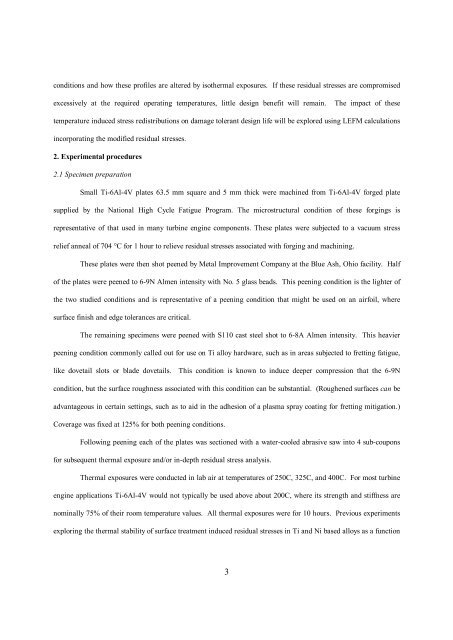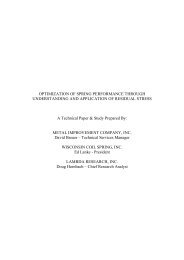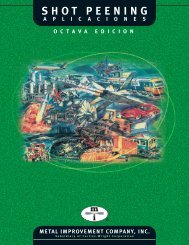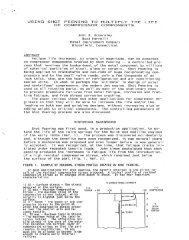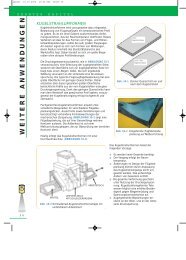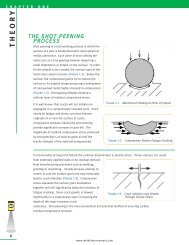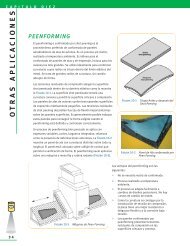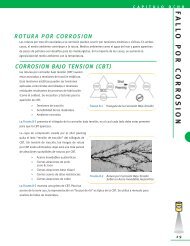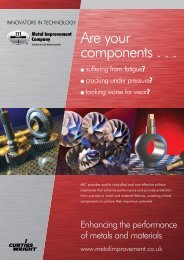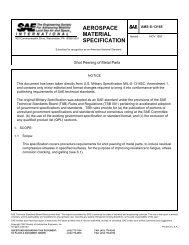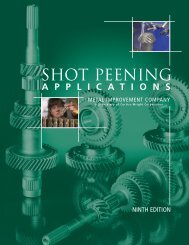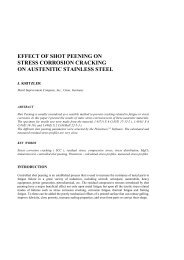Relaxation of Shot Peening Induced Residual Stresses in Ti-6Al-4V ...
Relaxation of Shot Peening Induced Residual Stresses in Ti-6Al-4V ...
Relaxation of Shot Peening Induced Residual Stresses in Ti-6Al-4V ...
Create successful ePaper yourself
Turn your PDF publications into a flip-book with our unique Google optimized e-Paper software.
conditions and how these pr<strong>of</strong>iles are altered by isothermal exposures. If these residual stresses are compromised<br />
excessively at the required operat<strong>in</strong>g temperatures, little design benefit will rema<strong>in</strong>. The impact <strong>of</strong> these<br />
temperature <strong>in</strong>duced stress redistributions on damage tolerant design life will be explored us<strong>in</strong>g LEFM calculations<br />
<strong>in</strong>corporat<strong>in</strong>g the modified residual stresses.<br />
2. Experimental procedures<br />
2.1 Specimen preparation<br />
Small <strong>Ti</strong>-<strong>6Al</strong>-<strong>4V</strong> plates 63.5 mm square and 5 mm thick were mach<strong>in</strong>ed from <strong>Ti</strong>-<strong>6Al</strong>-<strong>4V</strong> forged plate<br />
supplied by the National High Cycle Fatigue Program. The microstructural condition <strong>of</strong> these forg<strong>in</strong>gs is<br />
representative <strong>of</strong> that used <strong>in</strong> many turb<strong>in</strong>e eng<strong>in</strong>e components. These plates were subjected to a vacuum stress<br />
relief anneal <strong>of</strong> 704 °C for 1 hour to relieve residual stresses associated with forg<strong>in</strong>g and mach<strong>in</strong><strong>in</strong>g.<br />
These plates were then shot peened by Metal Improvement Company at the Blue Ash, Ohio facility. Half<br />
<strong>of</strong> the plates were peened to 6-9N Almen <strong>in</strong>tensity with No. 5 glass beads. This peen<strong>in</strong>g condition is the lighter <strong>of</strong><br />
the two studied conditions and is representative <strong>of</strong> a peen<strong>in</strong>g condition that might be used on an airfoil, where<br />
surface f<strong>in</strong>ish and edge tolerances are critical.<br />
The rema<strong>in</strong><strong>in</strong>g specimens were peened with S110 cast steel shot to 6-8A Almen <strong>in</strong>tensity. This heavier<br />
peen<strong>in</strong>g condition commonly called out for use on <strong>Ti</strong> alloy hardware, such as <strong>in</strong> areas subjected to frett<strong>in</strong>g fatigue,<br />
like dovetail slots or blade dovetails. This condition is known to <strong>in</strong>duce deeper compression that the 6-9N<br />
condition, but the surface roughness associated with this condition can be substantial. (Roughened surfaces can be<br />
advantageous <strong>in</strong> certa<strong>in</strong> sett<strong>in</strong>gs, such as to aid <strong>in</strong> the adhesion <strong>of</strong> a plasma spray coat<strong>in</strong>g for frett<strong>in</strong>g mitigation.)<br />
Coverage was fixed at 125% for both peen<strong>in</strong>g conditions.<br />
Follow<strong>in</strong>g peen<strong>in</strong>g each <strong>of</strong> the plates was sectioned with a water-cooled abrasive saw <strong>in</strong>to 4 sub-coupons<br />
for subsequent thermal exposure and/or <strong>in</strong>-depth residual stress analysis.<br />
Thermal exposures were conducted <strong>in</strong> lab air at temperatures <strong>of</strong> 250C, 325C, and 400C. For most turb<strong>in</strong>e<br />
eng<strong>in</strong>e applications <strong>Ti</strong>-<strong>6Al</strong>-<strong>4V</strong> would not typically be used above about 200C, where its strength and stiffness are<br />
nom<strong>in</strong>ally 75% <strong>of</strong> their room temperature values. All thermal exposures were for 10 hours. Previous experiments<br />
explor<strong>in</strong>g the thermal stability <strong>of</strong> surface treatment <strong>in</strong>duced residual stresses <strong>in</strong> <strong>Ti</strong> and Ni based alloys as a function<br />
3


